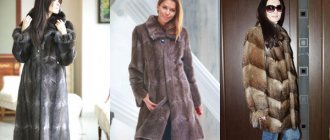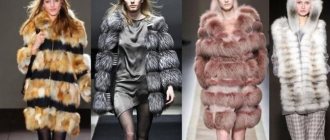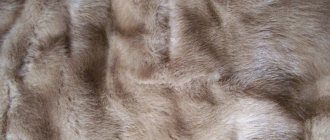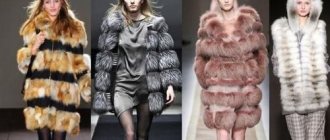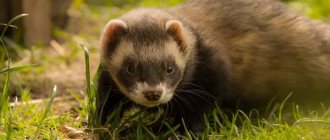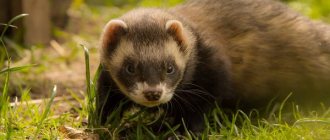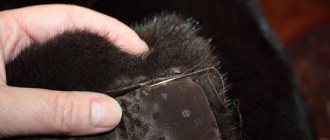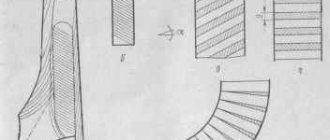Every woman’s wardrobe simply cannot be complete without a fur coat or sheepskin coat. When choosing such expensive outerwear, you should pay special attention. Of the numerous assortment of fur products, the muskrat fur coat in the photo deserves special attention. Tips and tricks from professionals will help you choose a very beautiful and high-quality product.
Choosing a muskrat fur coat
Muskrat fur: why is it so good?
Muskrat fur is very warm and light, which makes it possible to create fur models from it that are ideal for cold climates. Another important properties of such fur material are its moisture resistance and water-repellent abilities. Such outerwear will not be afraid of rain and wet snow.
Thanks to such positive characteristics, muskrat fur, as numerous reviews show, is considered the most practical. However, such fur coats are not very durable, and they can only withstand from 5 to 7 seasons. This disadvantage is compensated by the affordable cost of the product. This will allow you to buy several models of different styles and colors at once and alternate them with each other.
Why should you buy a muskrat coat?
Those who are planning to replenish their wardrobe with a high-quality and attractive fur product should learn in more detail about the exact advantages of a muskrat fur coat.
The main advantages of such products include the following:
- The muskrat coat shown in the photo will be an excellent solution for daily wear. The product goes well with a variety of fur hats, platform boots and elegant high-heeled boots.
- Muskrat fur has a very diverse color - from light beige shades to rich black tones.
- Muskrat coats have excellent thermal insulation abilities. This is due to the fact that the muskrat lives in fairly harsh climatic conditions, in which heat preservation is a mandatory property. At the same time, the fur has a very soft and silky texture.
- The fur of this animal can rightfully be called unique. Warm and light, it consists of soft and elastic hairs, which give the finished product a special appeal and originality.
- Thanks to the lightweight fur, muskrat coats are very comfortable and practical to wear. At the same time, the surface of the product visually resembles more expensive and elite mink outerwear, especially if the products are delivered from abroad - Cyprus, the Czech Republic.
Notes of an Astrakhan naturalist. Will mink kill muskrats?
Column author: Vladimir Pankov
We often talk about “foreign visitors,” that is, invasive species that have taken root in our region and often crowd out native plants or animals. Today we will talk about the American mink - despite its cute appearance, it is a fairly successful predator and many biologists accuse it of, for example, destroying the muskrat, by the way, also an invasive species imported from America. And Ilga Sokolova, senior researcher at the Astrakhan State Biosphere Reserve, candidate of biological sciences, will help me tell about the mink.
— First of all, let's clarify the issue of the appearance of the American mink in the Volga delta. When and how did this happen?
— The first sightings of American mink were recorded in the reserve in the second half of the 70s of the last century. These were individuals who escaped from fur farms, and their already “wild” offspring.
- So recently? But we already have a lot of minks, are they more common than any other animal, or so it seems, since they are not very afraid of people?
— Estimates of mink numbers in the reserve are based on data from winter route surveys. According to these data, as well as phenological observations, the number of American mink is very high, although it can fluctuate quite significantly from year to year. Most often, the saturation of suitable biotopes with this species approaches 100%.
The mink’s not very timid attitude towards humans is not particularly surprising and directly indicates its origin in Europe from captive specimens. This behavior of minks is recorded, for example, on our eco-trail, where they allow a person to get close, and can even come up to sniff. Most likely these are young and inexperienced animals, but nevertheless...
— Tell us about the life of minks - what is their hunting area?
— The hunting area of a mink is most often a rather narrow coastal strip with a length of 1 to 6 km, but most often no more than 2 km. In the reserve, she prefers to feed mainly on fish of a suitable size, crayfish and large aquatic insects. Minks also eat rodents, and since they hunt near water, they most often encounter muskrats and water voles. In addition, this species prefers to settle in muskrat burrows, rarely digging its own.
— Who are the mink’s natural enemies? What limits its numbers?
— Mink cubs appear already in March, and it is at this time that the species is most vulnerable due to low air temperatures, as well as early releases of cold water from the Volga Cascade. This is the main factor limiting the number of species in the reserve. The mink has few natural enemies. It competes only with the otter. But the otter is rarely aggressive towards the mink. Many predators do not specifically hunt minks because of the unpleasant odor inherent in all mustelids.
Young individuals leave the female closer to autumn, as with most predators. Males, I think, tend to kill teenagers of the same sex.
- Yes, for most animals the first year of life is the most difficult... Quite often I come across statements from fellow naturalists that minks destroy muskrats - how true is this? Have you noticed a relationship between the number of minks and muskrats and water voles in the reserve?
— In general, a mink hunts muskrats throughout the year, but only when a muskrat is caught in its hunting territory. But mass, targeted “genocide” occurs only in severe winters, when intense ice cover forms on streams and seashores - then the mink can destroy up to 60-70% of muskrat populations.
By the way, in the warm season, birds often become its prey, especially during nesting. Such a universal predator.
Just in case, I also asked for the opinion of a specialist I know from another region. As Ilya Smelyansky, an employee of the Siberian Environmental Center, said, the mink is unlikely to be able to seriously reduce the number of muskrats (or water voles). Of course, the mink catches rodents, but usually smaller ones, and the muskrat and water vole are quite rare prey, these animals are almost the size of a predator. Only during periodic outbreaks of muskrat or water vole numbers does the mink hunt them more often - but in these cases they are hunted by everyone who can handle them (or their beaks).
By the way, the mink is not the only representative of mustelids in our region; we are also home to ermine, weasel, and for several years, stone martens began to be periodically caught on camera traps installed by employees of the Astrakhan Biosphere Reserve. Unlike the mink, the stone marten came to our region on its own, but it is a very secretive animal, and I have not yet come across it. What kind of relationship does the mink have with its “relatives”?
Marten is found here, judging by camera traps, in gallery forests, also near water, in bushes, and in the rubble of fallen trees. It is unlikely that she often meets mink, but if so, the marten is larger. The stoat may have more overlap with the mink, but it is most often found quite far from water, hunting mainly terrestrial rodents. The ermine often settles in their settlements. But sometimes stoats live near the river and feed on frogs, large aquatic beetles. Such individuals may well intersect with a mink. And in this case the mink is already larger.
Weasels have not been seen in the reserve for a long time, perhaps precisely because of the mink.
In general, the American mink, raccoon dog, and muskrat have adapted well to the nature of our region and can already be said to have become an integral part of it. It is simply impossible to imagine the nature of the Volga delta without them now.
After them, we had, but independently, without direct human participation, a wild forest cat, a common jackal and a stone marten - nature lives according to its own laws, not fully understood even by scientists.
Color variations of muskrat coats
When choosing the perfect muskrat coat, be sure to pay attention to its color:
- The most popular models are those with natural colors. Muskrat fur can range from light beige and red tones to rich black and brown tones. At the same time, cropped models look very fashionable.
- Due to the fact that such fur lends itself well to dyeing, you can purchase muskrat coats in a wide variety of color variations - silver-blue, gray, light blue, red, etc.
No less varied are the styles of such fur products - long, short, with a belt, collar, hood, patch pockets; the choice will depend on personal preferences, the characteristics of the woman’s figure and age. Modern manufacturers also sew larger sizes, which will please those with curvy figures.
FUR QUALITY.
FUR QUALITY.
The value of fur is determined by five characteristics of the hair: thickness, height, softness, shine and wear.
1. Density. The thickness of the hair depends not so much on the number of hairs, but on their thickness. According to the density of fur, skins are usually divided into four groups: a) especially thick-haired (beaver, otter, arctic fox); b) thick-haired (sable, muskrat, rabbit); c) medium density (marten, squirrel, fox); d) sparsely haired (gopher, hamster).
2.Height. According to the height of the hairline, the skins are conventionally divided into 3 groups: a) long-haired - with a hairline height of more than 5 cm (fox, arctic fox); b) medium-haired - with hair height from 2.5 to 5 cm (sable, marten, rabbit); c) short-haired - with a hair height of less than 2.5 cm (mole and gopher). It is well known that skins with high and thick fur have the best heat-protective qualities.
3.Softness. It is generally accepted that the softest fur raw material is fur - the skins of mink, squirrel, sable, marten, arctic fox, fox, muskrat, nutria, otter.
4.Shine. The shine of the hair can be either glassy (sharp) or silky (softer). The lack of shine gives the fur a matte appearance. Fur with a silky sheen is considered the most valuable. 5.Wearability. The wearability of a fur product is the combination of the wear resistance of the hair and leather fabric, as well as the strength of the bond between the hair and it. As a rule, leather tissue lasts much longer than hair. Fur becomes unusable either due to significant damage to the hairline, or due to the appearance of worn areas, which reduce both the aesthetic and heat-protective properties of the product. In places of greatest friction, the fur becomes felted and gradually changes color. The durability of fur raw materials is determined by its natural properties, but much also depends on the skill of the furrier. Conventionally, there are 5 groups of furs, the first of which is the most wear-resistant, the last is the least durable. quality of fur. First group: otter, beaver, cat. Second group: astrakhan fur, mink, muskrat. Third group: sable, marten, sand squirrel, sheepskin, smushka. Fourth group: squirrel, ermine, rabbit. Fifth group: hare, gopher, hamster, mole. For those who want to have a complete understanding of the strength of furs, the comparative wear resistance of various types of raw materials in points is offered (the wear resistance of otter fur is taken as 100 points). Unplucked otter - 100 Plucked otter - 95 Wolverine - 100 Brown bear - 95 Kamchatka beaver - 95 Unplucked river beaver - 85 Natural sea seal - 85 Painted sea seal - 70 Natural seal (nerpa) - 80 Painted seal (nerpa) - 75 Natural raccoon — 75 Dyed raccoon — 60 Natural sable — 80 Leopard — 75 Natural skunk — 70 Dyed skunk — 55 Natural mink — 70 Dyed mink — 55 Natural soft marten — 65 Dyed soft marten — 50 Karakul — 60 Blue arctic fox — 60 Natural wolf — 60 Dyed wolf - 40 Sheepskin - 55 Natural mountain marten - 45 Dyed mountain marten - 45 Muskrat - 45 Poek - 45 White arctic fox - 45 Corsac fox - 45 Natural fox - 40 Painted fox - 35 Opossum - 40 Foal - 35 Unplucked nutria - 40 Black ferret — 35 Jackal — 27 Natural squirrel — 27 Painted squirrel — 20 Ermine — 25 Column — 25 Sand squirrel — 20 Marmot — 20 Klyam — 19 Cat — 17 Sharktail — 15 Goat — 15 Chinchilla — 15 Rabbit — 12 Moire — 10 Mole — 10 Common ground squirrel - 10 Chipmunk - 6 Hamster - 6 Brown hare - 5 Average service life, based on physical wear and tear, is 3-6 years for hats, 5-8 years for coats. However, for furs, it was decided to determine the wear time not by year, but by the number of seasons (the duration of the season on average is 4 months): fur quality Otter - 20 River beaver - 18 Seal - 17 Mink - 10 Belek - 7 Arctic fox - 7 Marten - 7 Seal (seal) - 6 Karakul - 6 Sheepskin - 6 Fox - 5 Muskrat - 5 Nutria - 5 Squirrel - 4 Marmot - 4 Sand squirrel - 3 Long-haired rabbit - 2 Hare - 1 The durability of fur pelts largely depends on their finishing; painted products lose 10-20% of their strength. Shearing, on the contrary, increases the wear resistance of furs, since sheared fur is not felted. The wear resistance of a sheared fur product increases by 20-40%. Fur pelts of the same type, but of different varieties, are worn differently. For example, products made from grade 1 rabbit skins last 2 times longer due to the greater density of the hair. The dependence of wear resistance on the variety is similar for other furs - mink, muskrat, fox, sheepskin. The best varieties of astrakhan fur (jacket) have high wear resistance, the worst (SSS, D, DA) have very little wear resistance, so they are not used for sewing coats, but are used for finishing. In general, based on the value and beauty of furs, they are divided into three groups. The first, most expensive, includes the fur of black and silver fox, sable, chinchilla, American mink, marten, beaver, otter, bear (all types), white and black wolf. The second group, medium in cost, includes the furs of red fox, squirrel, muskrat, wolverine and ferret. The third group includes the fur of Russian mink, hare, rabbit, and mole.
Choosing muskrat products correctly: advice from professionals
To ensure that the purchased muskrat fur coat, which has only the best reviews, pleases you with its quality, you should take the advice of professionals:
- A quality product should feel silky, shiny and soft to the touch. After ironing the fur from bottom to top, its hairs should not be deformed, and after compression, the fur should take its original shape.
- Before purchasing a fur coat, you will need to try it on. Good outerwear should not be too massive, but an overly light weight of the model should arouse suspicion. Unscrupulous manufacturers try to save fur by stretching it, which not only lightens the weight of the finished fur coat, but also makes it cold.
- All seams of the product must be neat and even. If the clothes were sewn using the correct technology, then they will fit well. If there is an unstitched lining at the bottom, one can judge the high quality of the product - the manufacturer simply has nothing to hide. That is why it is worth choosing fur coats from trusted fur factories, for example, Alef, or manufacturers in Cyprus and the Czech Republic.
There are some tricks that will allow you to determine the quality of muskrat fur:
- We look closely at the fibers of the product. Real muskrat fur has piles of varying thickness and length. From the base to the tip the thickness of the villus decreases. This also applies to the color, which becomes darker towards the end.
- In the case of cropped models, you can proceed as follows: take a hair and set it on fire. In the case of natural fur, according to numerous reviews, the aroma of burnt hair should appear, while artificial fur will smell like burning plastic.
What parameters will determine the cost of a fur coat?
By visiting the forum about muskrat fur coats, you can learn a lot of valuable information about choosing a quality product. Experienced girls give their own recommendations:
- The cost of a muskrat fur coat will directly depend on the quality of tailoring and materials, style, as well as the number of whole skins used. The country of origin also affects the cost of a fur product. If the products of the Alef factory are quite affordable, then products from Cyprus or the Czech Republic will cost a little more.
- If the price of a product is too low, then it is 100% defective.
- It is best to purchase fur products in specialized stores, since in case of unpleasant surprises they can always be returned or exchanged.
By following all these simple recommendations, you can choose a fashionable and high-quality muskrat fur coat.
Muskrat
Muskrat fur is beautiful, thick, and pleasant to the touch. Its color can vary from light ocher to almost black, although chestnut-brown shades are most common. Due to the fact that this animal spends most of its life in water, fur coats have excellent water-repellent properties. Considering that our winters are characterized by slushy and frosty weather conditions, this circumstance immediately puts the muskrat in the category of practical furs. Fur coats, jackets, and coats made from muskrat fur have quite a lot of advantages. Fur products made from this fur will perfectly warm you in any cold, and they are almost weightless and cozy. In the modern world, muskrat fur of gray and blue shades is most in demand. This color scheme adds charm, elegance, and style to the fur product. In the price category, muskrat fur is available to almost everyone; it is significantly lower than the cost of mink, sable, and beaver.
In the 70s of the last century, a fashion for breeding muskrats appeared in the USSR, which brought relatively good income to private entrepreneurs. Alas, the construction of farms for muskrats does not facilitate its breeding and, most importantly, does not improve the quality of fur. Fur from North America, the homeland of the muskrat, where the animal lives in natural conditions, is still considered the best in the world. Harvesting wild fur is not only a significant part of the economy of these territories, but also part of the culture, a local landmark, if you like, and fur fishing is a difficult job that requires real courage. Furs of the highest quality from the North-Eastern regions of Canada are sold under the GMVF brand as exclusive lots at international fur auctions. All skins from the GMVF collection comply with European requirements of the fur industry and are prepared in accordance with international rules for the civilized treatment of animals.
Muskrat fur is a wonderful addition to your wardrobe. Despite the fact that this fur does not occupy a high position among other furs, it is very common and in demand in our climatic conditions. The only drawback of this fur is its fragility. As a rule, fur products made from this fur are bought for five to six seasons. But this is also quite convenient. Over time, fashion changes, new styles and finishes appear, but due to the low cost of muskrat, you can always be the most fashionable. Muskrat, musk rat (lat. Ondatra zibethicus, eng. Muskrat) is a mammal of the subfamily of voles of the order of rodents; the only species of the muskrat genus. This semi-aquatic rodent, native to North America, is acclimatized in Eurasia, including Russia. Outwardly, the muskrat resembles a rat (it is often called a musk rat), although it is noticeably larger than an ordinary pasyuk - the weight of adult individuals can reach 1.8 kg, although, as a rule, they weigh 1-1.5 kg. Body length is 23-36 cm, tail length is almost equal to body length - 18-28 cm. Females do not differ in size from males. The muskrat's body is ridged, its neck is short, its head is small and blunt-faced. Its appearance indicates adaptation to an aquatic lifestyle. The ears barely protrude from the fur; The eyes are small, high set. The lips, like those of beavers, grow over the incisors, isolating them from the oral cavity, thanks to which the muskrat can bite off plants under water without choking. The tail is flattened on the sides, covered with small scales and sparse hairs; A ridge of elongated, coarse hair runs along its underside. There are swimming membranes on the hind legs, and a border of short hairs along the edges of the toes. The muskrat's fur consists of coarse guard hairs and soft undercoat. The color of the back and limbs ranges from dark brown to black. The belly is lighter, sometimes grayish-blue. In summer the color brightens. The fur is very thick, dense and lush, which makes it waterproof. The muskrat constantly monitors its fur: lubricates it with fatty secretions and combs it. Another adaptation to the aquatic lifestyle is the increased content of hemoglobin in the blood and myoglobin in the muscles, which creates additional oxygen reserves when diving under water. Another special adaptation is heterothermy, the ability to regulate blood flow to the limbs and tail; A muskrat's limbs are usually colder than its body. Initially, the muskrat was distributed in semi-aquatic biotopes of North America, almost everywhere - from Alaska and Labrador to Texas and northern Mexico. It was brought to Europe several times and eventually spread widely throughout Eurasia, right up to Mongolia, China and Korea. In Russia, the muskrat's range extends from the borders of Finland through the entire forest zone of the European part of Russia and a significant part of the forest-steppe and taiga zones of Siberia to the Far East and Kamchatka. The muskrat leads a semi-aquatic lifestyle, settling along the banks of rivers, lakes, canals and, especially willingly, freshwater swamps. It prefers shallow (1-2 m deep), non-freezing reservoirs with winding banks covered with dense grassy vegetation. Muskrats are active around the clock, but most often after sunset and early in the morning. They feed on coastal and aquatic plants - reeds, cattails, reeds, sedges, horsetails, arrowheads, and pondweeds. In spring, the muskrat feeds on young stems and leaves, in summer and autumn it eats root parts and rhizomes, and in winter only rhizomes. It also eats agricultural crops. Less often, when there is little plant food, it eats mollusks, frogs and fish fry. For housing, the muskrat builds holes and huts. He digs a hole in a high bank. The length of the burrow passages varies, on steep banks - 2-3 m, on flat banks - up to 10 m. The opening of the burrow is located under water and is not visible from the outside, and the nesting chamber is located above the water level. It happens that nesting chambers are located on two floors and connected by passages - this is provided in case of changes in the water level in the reservoir. Even in the most severe frosts, the temperature in the nesting chambers of muskrats did not fall below 0 ° C. On low, swampy shores, the muskrat builds above-water dwellings - huts up to 1-1.5 m high - from the stems of aquatic plants (reed, sedge, cattail), held together by silt. The entrance to them is also located under water. It also builds floating and open nests - feeding areas. In addition to living huts, muskrats also build storerooms where they store food for the winter. Muskrats live in family groups that have their own feeding areas. The inguinal (perineal) glands of males secrete a musky secretion with which they mark their territory. They are intolerant of aliens, only forming groups during wintering. In spring, females drive their grown offspring away from the site; During overpopulation, cases of cannibalism are known. In spring and autumn, muskrats, who do not have their own families and feeding areas, make long migrations in search of free bodies of water. Due to their abundance, muskrats play an important role in the diet of many predators, including elks, raccoons, otters, raccoon dogs, barn owls, harriers, alligators, and pike. Particularly great damage is caused to them by minks, which live in the same biotopes as muskrats and are able to penetrate into their burrows through underwater passages. On land, muskrats are hunted by foxes, coyotes and stray dogs. Even crows and magpies attack young animals. Occasionally, muskrat holes and huts are destroyed by wolves, bears, and wild boars. Usually the muskrat escapes from enemies under water or in a hole, but in a hopeless situation it can desperately defend itself using its teeth and claws. Slow on land, the muskrat swims well and dives well. She can do without air for up to 12-17 minutes. Vision and smell are poorly developed; the animal mainly relies on hearing. Pregnancy in a female lasts 25-30 days; There are an average of 7-8 cubs in a litter. In the northern regions there are 2 broods per year and reproduction is limited to the warm months - from March to August; in the south, reproduction is almost uninterrupted, and the female can feed 4-5 broods in a year. In the first weeks after birth, the male brings food to the lactating female, thus creating conditions for high survival of the cubs. The cubs are blind at birth and weigh about 22 g. On the 10th day they already know how to swim, and on the 21st they begin to eat plant foods. By the 30th day, young muskrats become independent, but remain with their parents for the winter. The resettlement of young muskrats occurs in the spring. Muskrats reach sexual maturity at 7-12 months. The maximum life expectancy is 3 years, in captivity - up to 10 years.
| The muskrat is one of the most important commercial fur species; it produces a valuable, durable pelt. The meat is edible; in North America this animal is even called the “water rabbit.” In a number of places, the muskrat's digging activity damages the irrigation system, dams and dams. It damages agriculture, especially rice farming; Having multiplied uncontrollably, it destroys aquatic and coastal vegetation. It is a natural carrier of at least 10 natural focal diseases, including tularemia and paratyphoid fever. The muskrat is a numerous and widespread species, since it is prolific and easily adapts to changes in its habitat - the construction of irrigation canals, etc. However, its numbers are subject to natural cyclical fluctuations - every 6-10 years, for reasons that have not yet been studied, it sharply falls. |
- Previous – Sheepskin (mouton)
- Next - Possum
